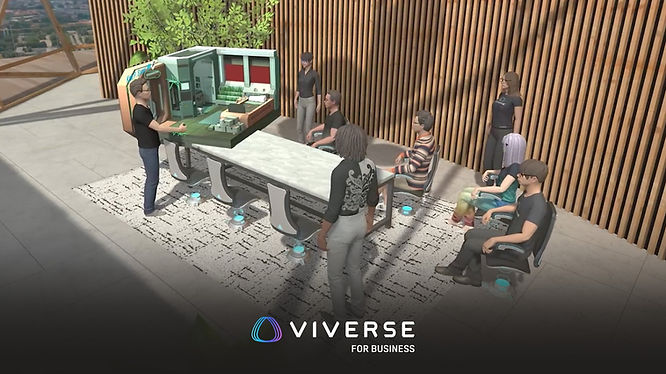Enhancing the Performance of Global and Remote Teams with Virtual Workspaces

The COVID-19 pandemic ushered in a profound transformation in the way businesses operate, with remote and hybrid work becoming the new standard for many organizations. While remote work brings flexibility and convenience, it also presents considerable challenges. These challenges include collaboration issues, diminished engagement, and the potential for employee isolation. The pandemic also cast a spotlight on how to enhance productivity for globally distributed teams in international companies. Fortunately, virtual reality (VR) technology has made remarkable strides, with platforms such as VIVERSE for Business offering a practical way to build engaging and effective virtual workplaces.
Collaboration for Global Teams
One of the biggest challenges in remote and distributed teams is maintaining connectedness. While 98% of remote workers want to stay remote at least part of the time, 53% feel it’s harder to stay connected with their colleagues, as reported by Forbes .
Reinforcing that point, a study by Microsoft showed that the shift to remote work during the pandemic resulted in less interconnectivity and collaboration, and increased isolation among employees. The study revealed that “working from home caused Microsoft employee groups to be less interconnected, less collaborative, and more siloed.” While email use surged, conveying complex information became more challenging for remote employees. This underscores the pressing need for solutions that enable better collaboration.
HTC’s VIVERSE for Business platform addresses these challenges through several core features. It supports virtual meetings, training sessions, and team-building activities. Additionally, it seamlessly integrates with Microsoft Teams and Zoom, facilitating connections between users on different platforms including PC and mobile. It also provides expressive avatars that enable employees to express themselves through their voice, movements, and 3D emojis.
Enhancing Engagement and Productivity
Another challenge lies in sustaining employee engagement and productivity. Remote work is best suited for independent tasks and deep thinking, while in-office work excels in collaborative, creative endeavors. A report from Fortune states, “Hybrid has proven to work—but only if it’s organized.” It’s clear that striking the right balance between remote and in-person work is key to the success of hybrid work.
This is exactly where VIVERSE for Business takes center stage, offering features that address these issues. The platform includes inspiring virtual spaces that encourage employees to unleash their creativity and imagination. These spaces include breakout meeting rooms with stunning views, auditoriums equipped for video presentations on large screens, exhibition rooms designed for viewing intricate 3D models, and even relaxation areas for informal discussions. It also includes shared whiteboards for group collaboration, and robust file-sharing tools that seamlessly integrate 2D work into the virtual reality environment. This includes support for popular file formats such as those from the MS Office suite. Importantly, it offers high-fidelity 3D model visualization with minimal impact on bandwidth, thanks to Polygon Streaming technology.
Additionally, expressive avatars allow people to communicate naturally with colleagues, just like they’re in the same office together. This goes a long way towards making the environment collaborative and engaging. For example, VIVERSE for Business supports photo-realistic avatars by scanning your face through a smartphone app.
Mitigating Isolation
Loneliness is an all-too-common issue among remote and distributed teams. Glassdoor’s 2022 survey showed that over a third of remote workers experience feelings of loneliness. Remote employees not only miss in-person interactions, but also struggle in connecting with colleagues. Roughly 40% of remote workers cited difficulty in connecting with colleagues, and 31% had difficulty building relationships with their colleagues. Addressing these feelings of isolation is important for employee well-being and job satisfaction.
By offering a more immersive online experience, VR can create a sense of presence and connection that video calls just can’t match. In fact, a study by PwC found that VR-trained learners felt an emotional connection to the content that was 3.75 times greater than classroom learners.
Additional research underscores the role of immersive technology in promoting connectivity. A 2022 paper published in the journal Computers in Human Behavior notes that “immersive VR technology may play an important role in fostering social connectivity and users’ well-being in scenarios where other options (e.g., face-to-face contact) are not available.”
Bringing Together Globally Distributed Teams
VR workspaces aren’t only beneficial for remote employees – they are also invaluable for globally dispersed teams. When businesses expand their operations worldwide, the challenge of maintaining cohesive teams across different time zones and geographic locations becomes daunting. VR enables global teams to converge in a shared virtual space, fostering collaboration as if they were in the same room. This is especially crucial for companies with an international presence and remote workers scattered across the globe.
While remote work presents its fair share of challenges, including collaboration issues, diminished engagement, productivity concerns, and feelings of isolation, virtual reality workplaces such as VIVERSE for Business offer a promising solution. The future of work may very well be a fusion of the physical and virtual, with VR playing a key role in shaping a more connected and productive workforce.
For more information about VIVERSE for Business, please visit our website and contact us.